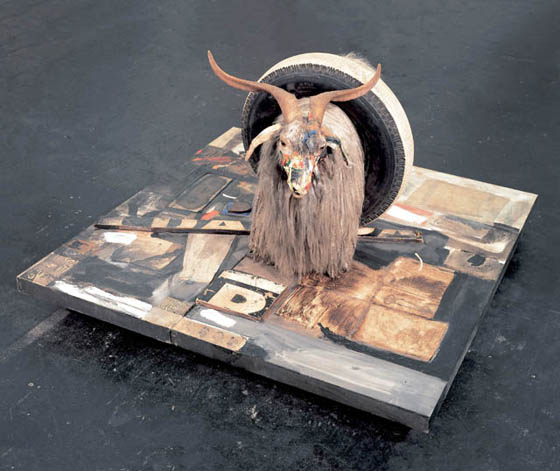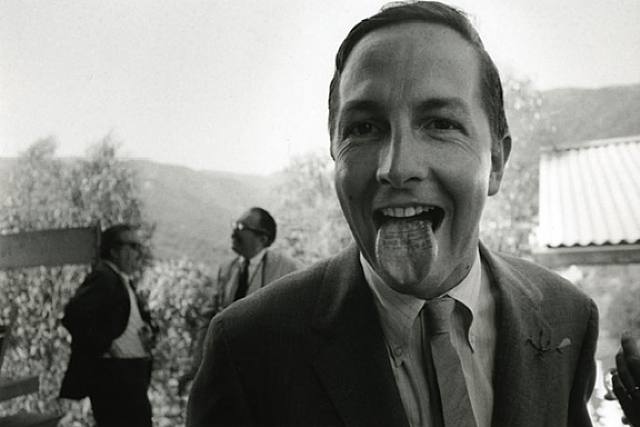Robert Rauschenberg – Monogram
There are few artists whose work I admire more than that of Robert Rauschenberg. Not only for his work itself, but how it pushed boundaries of how art was considered.
In 1964, after Robert Rauschenberg won the Venice Biennale Grand Prize, the Vatican newspaper L’Osservatore Romano deplored the event as “the total and general defeat of culture.”
from a Review of “Combines” by Jorg von Uthmann 2006
For me, in many ways, Rauschenberg’s work exists outside context. What I mean by that is that he wasn’t really associated with any one specific movement, and as his work evolved a lot over his very long working career, it’s hard to peg him down to any one specific style or even medium. Many of his pieces mix genres and art media freely, and while there are obviously some commonalities with his contemporaries, for the most part his work is its own context more than anything else that was going on in the art world at the time.
Robert Rauschenberg (October 22, 1925 – May 12, 2008) was an American painter and graphic artist whose early works anticipated the pop art movement. Rauschenberg is well known for his “Combines” of the 1950s, in which non-traditional materials and objects were employed in innovative combinations. Rauschenberg was both a painter and a sculptor and the Combines are a combination of both, but he also worked with photography, printmaking, papermaking, and performance. He was awarded the National Medal of Arts in 1993.
The one piece of Rauschenberg’s I most admire is Monogram, a mixed-media sculpture/ collage/ painting made of manipulated found objects. It appeals to my own aesthetic sensibility for many reasons, and in many ways. When I was in high school, our art teacher told me that Rauschenberg used to walk around his block in 1950’s New York, and pick through the trash in the empty lots, alleys, and garbage cans. If he found anything he thought he could use, he’d take it back to his studio. If he didn’t, well, he wouldn’t make any art that day. This may or may not be apocryphal but it appeals to me – not just as a fellow artistic trash-picker (you can find some great stuff, you know), but in that there’s a kind of poetry in working with the detritus of modern civilization; making objects of cultural relevance from the leavings of that culture. Then there’s the notion of the city’s cast-off items giving hints to a meta-narrative of what it is to be in the city, to the extent that the things you find in the trash are a key to the secret language of the city itself, like in Paul Auster’s story City of Glass from his New York Trilogy.

Robert Rauschenberg – Monogram (1955-59) mixed media
Now, I realize it reads like I’m over-analyzing, but hey, that’s what modern art’s all about. Like this bit from an awesome article about Rauschenberg on ArtNet:
That looking turned breathless in 1959 when Rauschenberg completed Monogram, one of the most outlandish and barbarous works of art ever made. Monogram features a stuffed Angora goat encircled by a tire. The goat, whose snout is covered in multicolored war paint, is standing on a painting, as if grazing at pasture. A sort of gargoyle or ravaging scavenger guarding over and also destroying art, this cloven-hoofed creature is a shamanic manifestation of Rauschenberg. In early Christian art goats symbolized the damned. This is exactly what Rauschenberg was as a gay/bisexual man and an artist, at the time. A dingy tennis ball behind the animal suggests it has defecated on painting. Allegorically, Rauschenberg is a bull in the china shop of art history, a satyr squeezing through the eye of an esthetic/erotic needle. As Johns’s Flag (1954-1955) is a Delphic rebel yell that says, “I create and am a part of this symbol of American openness even though as a gay man I am shunned by it,” so Monogram is Rauschenberg’s credo, a line drawn in the psychic sands of American sexual and cultural values. It is a love letter, a death threat, and a ransom note. It is Rauschenberg carving his monogram into art history.
– Our Picasso? from Artnet, by Jerry Saltz
I love the idea of the horny old goat as a tongue-in-cheek self portrait feeding off the art field while remaining disdainfully above it. So delightfully apocalyptic and a witty exploration of many of the concerns around figuration and modernism of the day – contrast this with the Abstract Expressionists’ obsession with the picture plane or Pop Artists’ with consumer culture. Anyhow, I like it, whether you think of it as a critique, a celebration, a sexual banner, a tongue-in cheek artistic in-joke, or some combination thereof. Monogram speaks to me not just as art, but as a window into Rauschenberg’s work and thought processes. If you would like to see more of Rauschenberg’s work, MoMA has a pretty decent online selection, or you can check out the online info related to the 2006 show focusing on Rauschenberg’s combines at Centre Pompidou in Paris. If you’re interested in a more detailed exploration, there’s always Robert Rauschenberg: Combines for a look specifically at the period of his career where he made “Monogram”, or a more thorough look at his, well, art and life can be found in Rauschenberg: Art and Life.
I leave you with this photo of Rauschenberg taken by Dennis Hopper at Claes Oldenburg’s wedding in 1966.

Dennis Hopper’s 1966 photo of Robert Rauschenberg with his tongue stamped “Wedding Souvenir, Claes Oldenburg”



[…] Robert Rauchenberg’s “Monogram,” exhibited at Stockholm’s Moderna Museet, is featured in an article here: http://www.greynotgrey.com […]